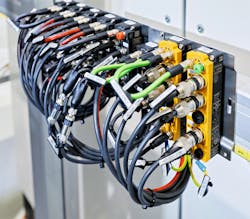Device-level communication offers precise synchronization for high-end motion control
Azad Jafari is I/O product manager at Beckhoff Automation.
Tell us about your company’s state-of-the-art industrial-networking technology.
Beckhoff technologies use EtherCAT as its communications backbone, and, even after two decades, the protocol is still helping us push boundaries. We are continuing to enhance performance and speeds, and the flexibility of EtherCAT helps us distribute high-end functionality across the machine.
What have been the biggest improvements to industrial-networking technology in the past five years?
Azad Jafari, I/O product manager, Beckhoff Automation: I would say open platform communications unified architecture (OPC UA). With built-in encryption, this technology makes the communication between the device level and higher-level, third-party systems much safer than before. At the device level, EtherCAT continues to offer unrivaled capabilities—free selection of topology, up to 65,535 nodes on a single network, real-time communication, simple integration of more than 30 traditional fieldbus protocols and zero switches required. By adding in protocols like OPC UA or message queuing telemetry transport (MQTT) or advanced message queuing protocol (AMQP) to the Beckhoff automation platform, we’re enabling seamless, secure communication from the sensor to the cloud for the smart factories of today and tomorrow.
What’s the most innovative or efficient industrial-networking technology application you’ve ever seen or been involved with?
Azad Jafari, I/O product manager, Beckhoff Automation: Engineers keep pushing the boundaries of what we all thought was possible. With the extremely precise synchronization of EtherCAT, some of the most impressive applications we see involve high-end motion control. That could relate to the application’s speed or sheer size. In terms of incredible speeds, the Pickfeeder machine from Packfeeder, which uses machine vision, robotics and an XTS linear transport solution to rapidly unscramble random infeed of bottles, provides a prime example.
One of the most impressive applications in terms of size has to be the Giant Magellan Telescope. The telescope uses seven mirrors with a combined diameter of 25 meters, and it offers a resolution 10 times greater than that afforded by the Hubble Space Telescope. The enclosure alone at the Las Campanas Observatory in Chile is 22 stories tall. More than 3,000 motion axes must synchronize on a single EtherCAT network for the precise control of this telescope. Various embedded PCs, servo motors and other automation technologies were specified for the project. The real-time coordination of these components will help the telescope peer back into the time just after the Big Bang to provide greater insights into the formation of our galaxy.
How has industrial-networking technology benefitted from remote monitoring and connectivity?
Azad Jafari, I/O product manager, Beckhoff Automation: Global manufacturing requires robust and secure, cloud-based remote connectivity and monitoring. This enables companies to run and manage their facilities and production much more efficiently. They can access their assets from all over the world and react to their maintenance needs much faster. This will reduce their downtime while using labor and engineering resources more efficiently. The simple integration of higher-level communication protocols with real-time fieldbus communication is key to making this a reality.
Can you explain how software development has changed industrial-networking technology design and production?
Azad Jafari, I/O product manager, Beckhoff Automation: The use of simulation tools, such as MatLab Simulink, in the design phase has improved time to market for many machine builders. Controls engineers can simulate their entire code before or while manufacturing their machines. The same goes for the fieldbus. If you are concerned about performance, you can simulate an EtherCAT network in these tools to show how it will operate with the controllers and field devices you plan to use. Using MatLab Simulink, EtherCAT can even simulate implementations that involve controller-area-network (CAN) application protocol over EtherCAT (CoE) and servo-drive profile over EtherCAT (SoE). You don’t need to have the controller on hand. Actually, this can help you properly size CPU requirements before you place your order.
When will industrial-networking technology become IT-friendly enough that engineers are no longer required for installation and operation?
Azad Jafari, I/O product manager, Beckhoff Automation: From our point of view, our network technology is already IT-friendly in that the IT department doesn't have to worry about an industrial fieldbus. While EtherCAT is Ethernet-based, it never required IP addresses or switches to operate in industrial applications. This alone helps ensure separation between IT and engineering, so each department can focus on what they do best. IT should make office networks and business systems work best for the company, and the engineers should retain ownership of the machine and plant networking. Who do you really want to work on networked programmable logic controllers (PLCs) and servo drives?
What future innovations will impact the use of industrial-networking technology in discrete-manufacturing operations?
Azad Jafari, I/O product manager, Beckhoff Automation: In the future, we foresee some use cases for an improved time-sensitive-networking (TSN) technology in discrete manufacturing. TSN could work well as a higher-level communication system in conjunction with other deterministic networks that stay on the plant floor, especially EtherCAT. In fact, many of the networking enhancements that TSN is supposed to provide—greater synchronization and determinism, for starters—are inherent in EtherCAT solutions that are already available and proven in the field today. TSN will have its place, but we don’t see it as the leading solution for field-level communication between industrial components.
About the Author
Mike Bacidore
Editor in Chief
Mike Bacidore is chief editor of Control Design and has been an integral part of the Endeavor Business Media editorial team since 2007. Previously, he was editorial director at Hughes Communications and a portfolio manager of the human resources and labor law areas at Wolters Kluwer. Bacidore holds a BA from the University of Illinois and an MBA from Lake Forest Graduate School of Management. He is an award-winning columnist, earning multiple regional and national awards from the American Society of Business Publication Editors. He may be reached at [email protected]

Leaders relevant to this article:




